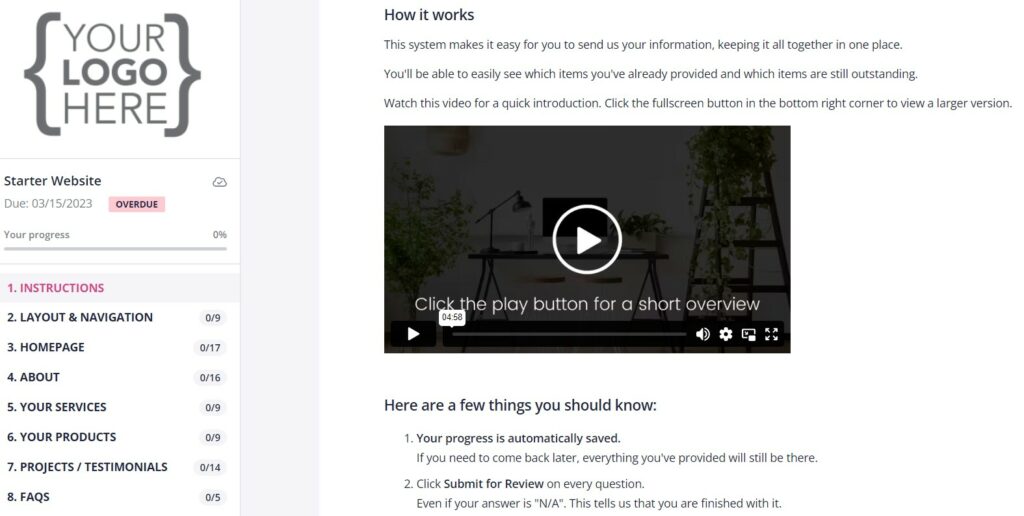If you've ever been involved in a project, big or small, you know that getting it off the ground can sometimes feel like untangling a plateful of spaghetti with a spork.
That’s the problem with not having a well-structured project intake process — it undermines your productivity and gradually deteriorates client relationships. That’s why B2B companies need a plan on how to manage project requests in a way that ensures consistency and efficiency.
In this post, we’ll show you how to do just that.
Let’s dive in!
Project intake process: What is it exactly?

The project intake process is a structured approach organizations use to assess potential projects before the actual initiation.
It serves as a gatekeeping mechanism, as you want to work only on projects aligned with your company’s strategic objectives and available resources. However, well-structured intake processes also help you streamline client onboarding, so you can do your job faster and more efficiently.
| Project intake process vs. client intake processThe client intake process refers to the initial steps taken to onboard a new client. It typically involves gathering information about the client's needs and requirements to ensure a successful working relationship. On the other hand, the project intake process focuses specifically on the initiation of a new project within an organization. It means evaluating and prioritizing project requests, resource allocation, and the establishment of project objectives and scope. |
Challenges of project intake processes

Inadequate project documentation
Inadequate project documentation hinders your intake process by causing misunderstandings and misaligned expectations. Let’s say you failed to clarify and document project goals. In this case, the project team will struggle to develop accurate estimates.
To address this challenge, you need to properly manage project documentation. It’s best to use document templates, checklists, guidelines, and data collection tools to capture essential information consistently.
No stakeholder involvement
You can’t get the job done if you never get to reach all parties involved in the project. Failure to engage key stakeholders from the outset often results in delayed decision-making and resistance to project implementation.
A typical project manager will benefit from client onboarding automation. They could also determine one or two communication channels to foster collaboration, while project meetings and feedback sessions can also help kickstart the process.
Lack of standardization
The absence of standardized procedures is also problematic. In this case, you’ll have to approach each project differently, which leads to inefficiencies, confusion, and increased administrative overhead. That’s exactly why you should establish clear intake guidelines for all types of projects.
Key steps of a successful intake process

Companies that fail to standardize intake processes spend much more time evaluating project proposals. If you still haven’t designed your project intake process, you can do it by following these nine steps:
1. Project Request
The first step in the intake process is receiving a project request. This can come from various sources like clients, stakeholders, or internal departments. At this stage, your only task is to properly document incoming project requests.
2. Establish project selection criteria
Once project requests start coming in, it's necessary to define project selection criteria. These criteria act as guidelines for assessing requests based on:
- Their alignment with organizational goals
- Available resources
- Strategic importance
- Potential impact
- Feasibility
The decision-making process becomes more objective and consistent if you establish selection criteria upfront.
3. Create a standardized project intake form
Creating a standardized project intake form is highly beneficial for those eager to streamline the intake process. This form includes relevant fields for capturing essential project details: project name, description, objectives, expected outcomes, timelines, budgetary requirements, and any other pertinent information.
A standardized project intake form ensures consistency, as you’ll capture all necessary information for each project request in a timely and efficient manner.
4. Gather information with the best data collection tools

Collecting information for new project requests often turns into the first serious bottleneck of the intake process. But there is a way out!
New technologies significantly improve the intake process, so why not take advantage of them to collect data and documents about project proposals? For instance, Content Snare is specifically designed for gathering data from clients. With our platform, you can:
- Create customizable forms
- Automate reminders
- Centralize all project-related information in one place
- Reject or accept information or files
- Leave comments to clarify some aspects of your project intake form
Content Snare helps you streamline the intake process by reducing manual effort.
Build project intake forms with Content Snare
Simplify the way you capture project information with customisable forms and questionnaires — or use one of our growing number of ready-made templates.
5. Conduct initial project reviews
After receiving project requests, the next step in the intake process is to conduct initial project reviews. This involves evaluating each project request based on the established selection criteria (as explained in step 2).
The purpose of this review is to gain a better understanding of the project's scope, requirements, potential challenges, and overall feasibility. It also allows for an initial assessment of whether the project aligns with the goals or capacities of your organization.
6. Prioritize projects
The next step is to prioritize projects. This means ranking each project proposal based on its strategic importance, potential impact, urgency, and available resources. Prioritization enables you to focus on project requests with the highest value.
The goal of this step is to help you manage resource allocation more efficiently, so you can address the most critical projects first.
7. Allocate resources
Resource allocation is a critical stage of the project intake process because it tells you what you need to get the job done. A typical project requires these resources:
- Human resources
- Budget
- Equipment
- Technology
The project intake team needs to consider the availability of resources, so you can make informed decisions on how to prepare for the actual execution. However, resource allocation also means considering potential conflicts or dependencies between projects.
8. Obtain approvals
Another important phase of the project intake process is to obtain approvals from relevant stakeholders. These usually include project sponsors and department heads. This step serves multiple purposes:
- It ensures that the project is aligned with the overall organizational strategy
- It gives stakeholders the opportunity to review and provide feedback on the project
- It establishes a formal commitment to support the project
9. Communicate project decisions
Last but not least, you have to communicate project decisions to all relevant parties.
This includes both the approval of selected projects and the rejection of others. Transparent communication walks the extra mile to explain the rationale behind each decision. That way, you can avoid confusion and reduce potential resistance or pushback.
Benefits of building a solid project intake process
Polishing your project intake process may seem daunting at first, but it’s necessary for a range of reasons. Here are just a few benefits of standardizing project intake processes:
Streamlined communication and alignment

A well-structured project intake process acts as a conduit for effective communication. Let us give you an example — imagine a software development team working on a new application without a solid project intake process.
With no clear understanding of the client's requirements, the team will likely end up building a product that fails to meet expectations, resulting in costly rework and strained relationships.
Prioritization and resource allocation
Decision-makers can only make informed choices if they define clear criteria for project selection. We are talking about factors like strategic alignment, return on investment, or resource availability.
Consider a marketing department flooded with multiple campaign ideas. With a project intake process in place, the team can assess each proposal's potential impact and allocate resources accordingly.
Risk mitigation

A thorough project intake form will help you identify and address potential risks early in the project lifecycle. By conducting thorough feasibility studies and risk assessments during the intake phase, organizations can proactively mitigate risks and develop effective contingency plans.
Higher project success rates
Improved intake processes maximize the likelihood of project success. If you set clear objectives and conduct thorough assessments before project initiation, you’ll greatly increase feasibility. In addition, this holistic approach creates a culture of achievement within the organization.
Efficient resource utilization
You can also optimize resource utilization by matching projects with available capacity and skill sets. The intake process prevents resource bottlenecks, so you can assign the right people to the right projects at the right time. Here’s what you get in return:
- Increased productivity
- Reduced idle time
- Efficient utilization of resources
- Streamlined client onboarding
- Cost savings
- Improved overall performance
Continuous improvement and learning
Formal intake processes also deliver long-term benefits. By capturing project data and lessons learned, your company can accumulate valuable knowledge for future endeavors. In addition, this knowledge repository serves as a foundation for refining the project intake process.
Over time, your organization will become more adept at selecting and executing projects.
Improve your project intake process to streamline efficiency
Projects come in all shapes and sizes, and that’s what makes people confused. But here’s the thing — most companies can solve intake process issues with the right data collection tool.
Content Snare improves your work by helping you design a perfect project intake form. You can use it to request project-related information, files, or documents. Your clients will see bite-size chunks instead of bulk requests, so they can give you accurate information in a timely manner.



